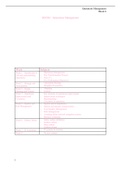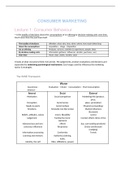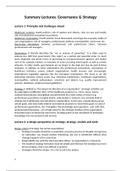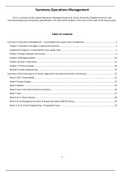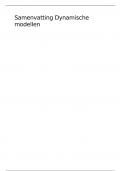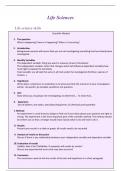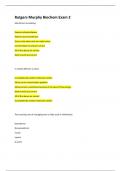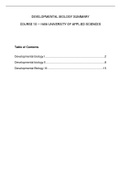Block 8
BOOM – Operations Management
Week Subjects
Week 1 – Introduction to o Operations Management
OM and understanding o The Transformation Process
Operations. o Four V’s
o Five Performance Objectives
Week 2 – Strategy and - Operations Strategy
Sustainability - Doughnut Economics
Week 3 – People, o Planning
Planning and Control o Control
Week 4 – Operations - Key elements of operations improvement
Improvement and - Improvement techniques
Circularity - Benchmarking
- Circularity in operations
Week 5 – Quality and o Quality and its importance
Risk Management o Quality and measure characteristics
o Total Quality Management
o Risk Management
o Avoiding failure and risk mitigation actions
o Business continuity
Week 6 – Safety Culture - Safety culture definition
- Surface culture
- Deep culture
- Culture of trust
Week 7 – IT in aviation o IT systems in aviation
Week 8 – - No new content
1
, Operations Management
Block 8
Week 1 – Introduction to OM and understanding the Operation
Operations Management
Operations Management (OM) can be defined as
the management of the entire process that
transfers inputs into outputs. Inputs can be
materials, manpower and machines. Outputs are
physical goods or services.
A central aspect of OM is the improvement of the
transformation processes which can be
accomplished by concepts such as ‘Total Quality
Management’, ‘Kanban’, or ‘Total Productive
Maintenance’.
The Transformation Process
Transformed resources are the things that are going to be
changed. You bring this together with the materials,
information and customers. On the other side you have the
facilities staff, the people who work on the resources. And we
have the transforming resources, think of machinery,
mechanics and computers. These four elements are the input of
the transformation process. The output of the transformation
process are the goods and services.
Input to the Process
Transformed resources; resources that are treated, transformed or converted in the
process. They are a mixture of:
o Materials,
o Information,
o Customer.
Transforming resources; these are the resources which act upon the transformed
resources. They are two types:
o Facilities, building, machinery, drink, food, etc.
o Staff.
Within the Process
Materials processing; transforms material’s physical properties, location, possession
or materials are stored.
Information processing; transforms information properties, possession, location or
information is stored.
Customer processing; transforms customer’s physical properties, location,
physiological state, psychological state or store (accommodate) customers.
2
, Operations Management
Block 8
Output of the Process
Outputs from process can be differentiated between products and service-based
organizations; tangibility of products and intangibility of services.
Most operations produce both products and services.
Services and products are merging; all operations are service providers who may
produce products as a means of serving customers.
Product is something tangible.
A service is something that after you buy it there is nothing left. So, for example what KLM
offers. You as a customer go in the transformation process and the output is being on a new
destination.
Four V’s in Operations
The four V’s in Operations Management are:
Volume of the output.
o Is also known as the quantity.
Variety of the output.
o This is the amount of different types of a product or service.
Variation in the demand of the output.
o How variable the demand for the product or service is over time. For example.
Bread has a very stable demand, no strong seasonality, so a low variation. A
ticket of Transavia to the Mediterranean has a high variation. This is because
the demand is not stable and a high variation in demand during specific
seasons.
Visibility (degree of) which customers have of the creation of the output.
o This is the degree of the way a customer is seeing the transformation process.
For example. With a ticket of KLM, you are part of the transformation
process, so there is a high visibility. With the making bread, you only see the
end result and not the transformation process, so there is a low visibility.
The implication of the four V’s.
This is mainly based on the unit
costs. The low and high of Volume
are switched because the lower your
quantity the higher the unit costs. The
higher the quantity, the lower the unit
costs.
With variety the same, the higher the
variety, the more machines and
products are needed, this means a
higher unit cost. The lower the
variety, the lower the unit costs.
! Always explain what you are comparing it to!
3


